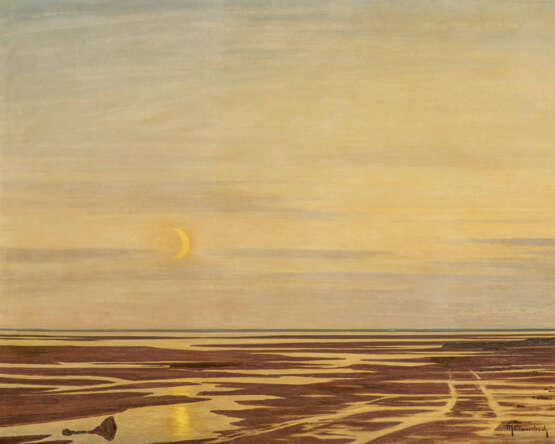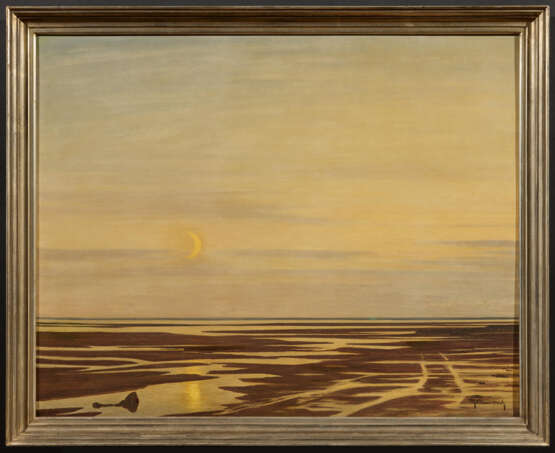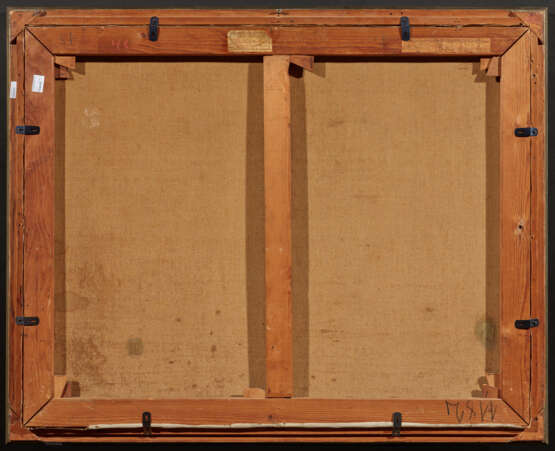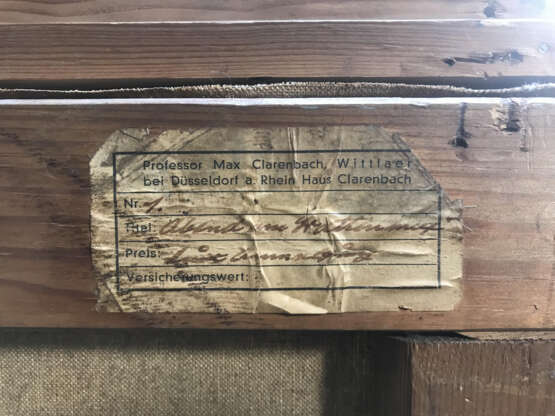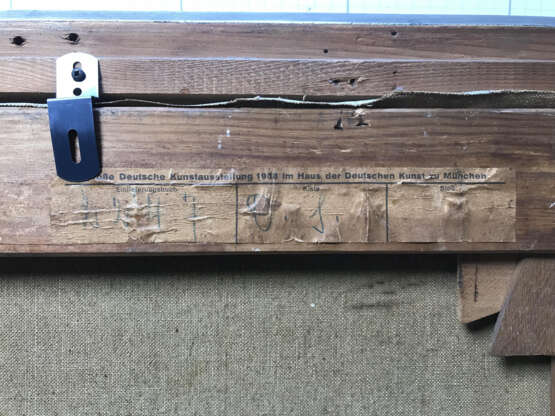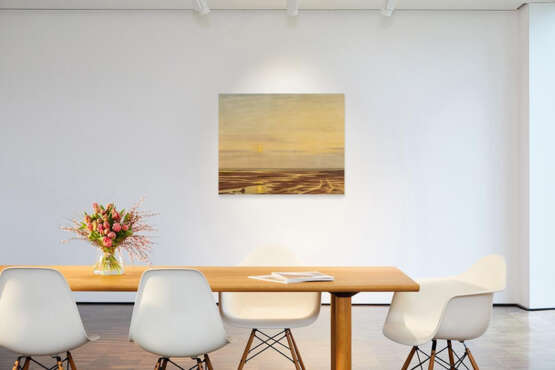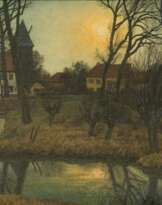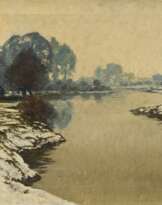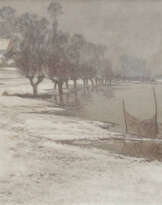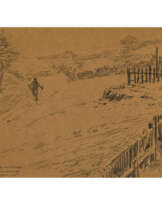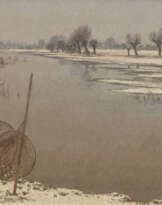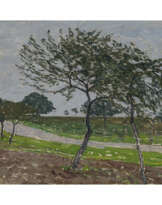Max Clarenbach. Abend im WattenmeerMax Clarenbach. Abend im Wattenmeer
17.05.2024 18:00UTC +01:00
Classic
Prix de départ
12000EUR € 12 000
| Auctioneer | VAN HAM Kunstauktionen GmbH |
|---|---|
| Lieu de l'événement | Allemagne, Köln |
| Commission | 32% |
Archive
La vente aux enchères est terminée. Vous ne pouvez plus enchérir.

ID 1208203
Lot 1220 | Max Clarenbach. Abend im WattenmeerMax Clarenbach. Abend im Wattenmeer
Valeur estimée
€ 12 000 – 18 000
Title: "Abend im Wattenmeer".
The Sea at Low Tide near Sylt.
Technique: Oil on canvas.
Measurement: 95 x 121cm.
Notation: Signed lower right: "M. Clarenbach".
Frame: Framed.
Verso:
On the stretcher studio stamp with details of the title as well as exhibition label from the Münchener Deutschen Kunstausstellung from 1938.
Provenance:
Private ownership, Germany.
With Max Clarenbach, the Düsseldorf School of Painting took a step towards Impressionism and more modern artistic concepts in the first years of the new century. In 1909, he was a co-founder of the Sonderbund, which brought together artists, collectors and museum experts who - similar to the Secessionists in Berlin - broke up the old academic structures and showed the new trends coming from Paris. Clarenbach was a decisive motor, who, in addition to his art, also pushed the organisation of the exhibitions in which the works of van Gogh, Monet and Gauguin were shown for the first time in Cologne and Düsseldorf.
He was by no means born with these visionary ideas. Clarenbach came from a very poor background and, orphaned at an early age, earned himself a place at the Düsseldorf Academy at the age of 13 with the help of patrons. Discovered by Andreas Achenbach, he was able to set off on study trips with the landscape painters at an early age. In 1899 he found the place that was to dominate his life and work: for the International Watercolour Exhibition, in which he was the only one of the Academy's students to take part, he lived in Wittlaer on the Rhine - he felt so connected to the Rhine and Erft meadows there that they became his predominant motif throughout his life and he built his studio house there ten years later.
His first artistic breakthrough came at the age of 22, when his expansive painting "Der Stille Tag" ("The Quiet Day") was exhibited in 1902 and immediately acquired by the Düsseldorf Art Museum. This winter landscape with two boats on the water already shows the typical elements of his painting that characterise his later work and form the basis of his success: the simple but atmospheric ambience in a seemingly random and insignificant picture detail, the reduction of the drawing, combined with graphic elements and an equally reduced colour palette. Clarenbach's paintings are characterised by a striking horizon, which is given depth by diagonal shorelines, often contrasted with reflections of boats in the water. Figurative or narrative elements are rarely or never found.
In the years before 1910, he was influenced by Impressionism of the French school, which he became acquainted with during his stays in Paris, and the works of the Haag School, which he encountered on his travels to Holland. The colours of his garden and flower paintings of the time are correspondingly vibrant and the application of paint correspondingly impasto. This changed in the mid-1910s; he became a professor at the Düsseldorf Academy and increasingly turned back to the traditional views there. Clarenbach was firmly rooted in the academic and artistic life of the city. During the 1930s/40s, he was able to remain true to his style, which did not fundamentally contradict the ideal of the time, even if he was initially criticised for his impressionistic approach. It was not until around 1940 that he approached pathetic, monumental landscape painting for a while, until he left teaching after 1945 and returned to his successful winter landscapes and spring gardens in his late work.
Max Clarenbach was one of the most important figures in the Rhineland's art scene in the early 20th century, and his atmospherically dense depictions of the Lower Rhine characterise the image of this vast landscape.
CLARENBACH, MAX1880 Neuss - 1952 Wittlaer/Düsseldorf
Titel: "Abend im Wattenmeer".
Das Meer bei Ebbe vor Sylt.
Technik: Öl auf Leinwand.
Maße: 95 x 121cm.
Bezeichnung: Signiert unten rechts: "M. Clarenbach".
Rahmen: Rahmen.
Rückseitig:
Auf dem Keilrahmen Atelieretikett mit Angabe des Titels sowie Ausstellungsetikett der Münchener Deutschen Kunstausstellung von 1938.
Provenienz:
Privatbesitz, Deutschland.
Mit Max Clarenbach erlebte die Düsseldorfer Malerschule in den ersten Jahren des neuen Jahrhunderts einen Schub hin zum Impressionismus und moderneren Kunstauffassungen. Er war 1909 Mitbegründer des Sonderbundes, unter dessen Dach sich Künstler, Sammler und Museumsfachleute zusammenschlossen, die - ähnlich zu den Secessionisten in Berlin - die alten akademischen Strukturen aufbrachen und die neuen, aus Paris kommenden Strömungen zeigten. Clarenbach war hier ein entscheidender Treiber, der neben seiner malerischen Tätigkeit die Organisation der Ausstellungen vorantrieb, in denen erstmals die Werke van Goghs, Monets oder Gauguins in Köln und Düsseldorf gezeigt wurden.
Diese visionären Gedanken waren ihm bei weitem nicht in die Wiege gelegt. Clarenbach stammte aus sehr ärmlichen Verhältnissen und erarbeitete sich, früh zum Waisen geworden, mit Hilfe von Förderern schon mit 13 Jahren einen Studienplatz an der Düsseldorfer Akademie. Von Andreas Achenbach entdeckt, konnte er schon früh mit den Landschaftsmalern zu Studienreisen aufbrechen und fand 1899 zu dem Ort, der sein Leben und Werk beherrschen sollte: für die Internationale Aquarellausstellung, an der er als einziger der Studenten der Akademie teilnahm, wohnte er in Wittlaer am Rhein - den dortigen Rhein- und Erftauen fühlte er sich so verbunden, dass sie zeitlebens zu seinem vorherrschenden Motiv wurden und er dort zehn Jahre später sein Atelierhaus baute.
Sein erster künstlerischer Durchbruch gelang ihm mit 22 Jahren, als sein raumgreifendes Gemälde "Der stille Tag" 1902 ausgestellt und sofort vom Düsseldorfer Kunstmuseum erworben wurde. Diese Winterlandschaft mit zwei Booten auf dem Wasser zeigt schon die typischen Elemente seiner Malerei, die sein späteres Werk charakterisieren und Grundlage seines Erfolges sind: die schlichte, aber stimmungsvolle Atmosphäre in einem scheinbar zufälligen und unbedeutenden Bildausschnitt, die Reduktion der Zeichnung, verbunden mit graphischen Elementen und einer ebenso reduzierten Farbpalette. Clarenbachs Bilder sind geprägt von einem markanten Horizont, der durch diagonale Uferlinien eine Tiefe erhält, oft kontrastiert mit Spiegelungsmotiven der Boote im Wasser. Selten bis nie finden sich figürliche oder erzählende Elemente.
In den Jahren vor 1910 ist er geprägt vom Impressionismus französischer Schule, den er während seiner Aufenthalte in Paris kennenlernt und den Werken der Haagschen Schule, dem er auf seinen Reisen nach Holland begegnet. Demensprechend kräftig sind die Farben seiner Garten- und Blumenbilder der Zeit und demensprechend pastos der Farbauftrag. Dies ändert sich Mitte der 1910er Jahre; er wird Professor an der Düsseldorfer Akademie und wendet sich wieder vermehrt den dortigen traditionellen Auffassungen zu. Clarenbach ist fest verwurzelt im akademischen Betrieb und künstlerischen Leben der Stadt. Während der 1930/40er Jahre kann er seinem Stil, der dem damaligen Ideal nicht grundsätzlich widersprach, treu bleiben, auch wenn er anfangs noch aufgrund seiner impressionistischen Auffassung kritisch gesehen wird. Erst um 1940 nähert er sich für einige Zeit der pathetisch-monumentalen Landschaftsmalerei an, bis er nach 1945 aus dem Lehrbetrieb ausscheidet und sich in seinem Spätwerk auf die erfolgreichen Winterlandschaften und Frühjahrsgärten rückbesinnt.
Max Clarenbach ist im frühen 20. Jahrhundert eine der bedeutendsten Persönlichkeiten im Kunstbetrieb des Rheinlandes, seine atmosphärisch dichten Anschichten vom Niederrhein sind prägend für das Bild dieser weiten Landschaft.
| Artiste: | Max Clarenbach (1880 - 1952) |
|---|---|
| Technique appliquée: | Huile |
| Catégorie maison de vente aux enchères: | Peinture 19ème siècle |
| Artiste: | Max Clarenbach (1880 - 1952) |
|---|---|
| Technique appliquée: | Huile |
| Catégorie maison de vente aux enchères: | Peinture 19ème siècle |
| Adresse de l'enchère |
VAN HAM Kunstauktionen GmbH Hitzelerstr. 2 50968 Köln Allemagne | ||||||||||||||
|---|---|---|---|---|---|---|---|---|---|---|---|---|---|---|---|
| Aperçu | |||||||||||||||
| Téléphone | +49 221 92586215 | ||||||||||||||
| Fax | +49 221 92 58 62 4 | ||||||||||||||
| Commission | 32% | ||||||||||||||
| Conditions d'utilisation | Conditions d'utilisation | ||||||||||||||
| Heures d'ouverture | Heures d'ouverture
|
